Bright and exotic guest in the garden: tomato "Orange"
The Orange variety has become the leader among orange tomatoes in our country. Tall bushes with exotic fruits give a good harvest of tomatoes. Their great taste and unusual color are popular with both adults and children. The vegetable has a strong immune system and is unpretentious to care for.
In order to avoid mistakes during cultivation, it is better to rely on the reviews of experienced vegetable growers and know the characteristics of this variety in advance.
The content of the article
Description of the variety
Tomatoes Orange is a semi-determinate (that is, unlimited growth) mid-season tomato variety. This variety loves warmth, so it is more suitable for greenhouses.
The vegetable is tall, occupies a smaller area than other types of tomatoes. The height of the bush sometimes reaches 150 cm, the plant branches heavily and needs support. The bushes are covered with medium-sized foliage. Inflorescences are formed above 8-9 leaflets. By type, subsequent inflorescences are subdivided into simple and intermediate and are formed after 2-3 leaves.
Advantages and disadvantages
The advantages of the species include:
- high productivity;
- aesthetic appeal;
- excellent taste;
- pleasant aroma;
- compactness of bushes;
- health benefits.
The fruits of the Orange variety normalize the digestive tract and can be used for baby food.
The variety also has disadvantages: the vegetable is very delicate, which makes it difficult to transport and cannot be stored for a long time.... In addition, the bushes must be tied up and pinned, otherwise the yield is significantly reduced. The orange cannot be called early ripening. Fruits are harvested 100-120 days after planting seedlings into the ground, and with direct seeding, the wait will take even longer.
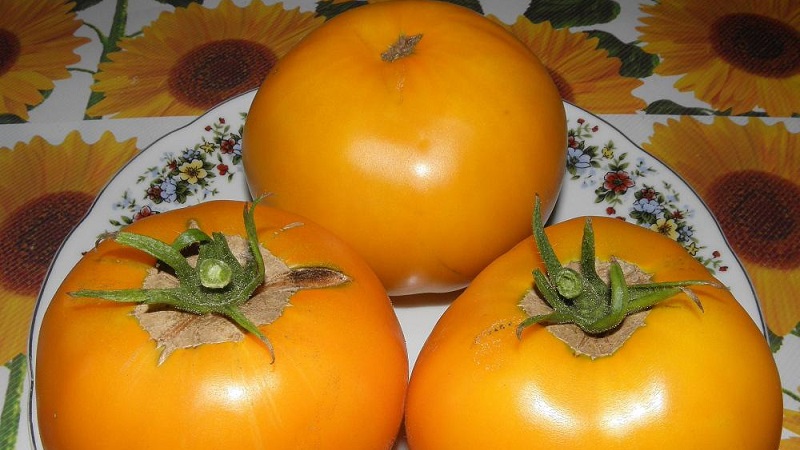
Fruit characteristics
Tomatoes are covered with an attractive bright yellow or orange peel with few longitudinal yellow stripes. Tomatoes are round in shape, weighing 0.2-0.3 kg, and in especially favorable conditions the mass of vegetables sometimes reaches 400 g. The skin is soft, but strong, capable of protecting the vegetable from cracking. The smell is slightly sweet and pleasant.
The pulp of tomatoes is sweet and fleshy with a slight sourness, it contains 3.2% sugar and 6.2% dry matter. When cutting a tomato, 2-3 chambers with a small amount of seeds can be seen inside. Vegetables are often consumed fresh. This allows you to preserve its aroma and beneficial properties. The tomato is suitable for dietetics and allergy sufferers, as well as for the preparation of pastes and juices. The fruits are also used for preservation for the winter.
Yellow tomatoes Recommended for people who are deficient in carotene and vitamins. The vegetable normalizes the digestive tract and eliminates characteristic diseases.
On a note. Tomato variety Orange is non-hybrid, therefore, for growing crops in the future, seed material can be harvested independently.
The nuances of cultivation
Although the Orange tomato is intended for cultivation in the southern regions, it is nevertheless done everywhere. The variety grows well in temperate climates, as it is mainly cultivated in seedlings.
Before sowing seed material treated with a growth stimulant and disinfected in a solution of potassium permanganate. 60 days after the appearance of the first shoots, the seedlings are ready for transplanting into open ground.
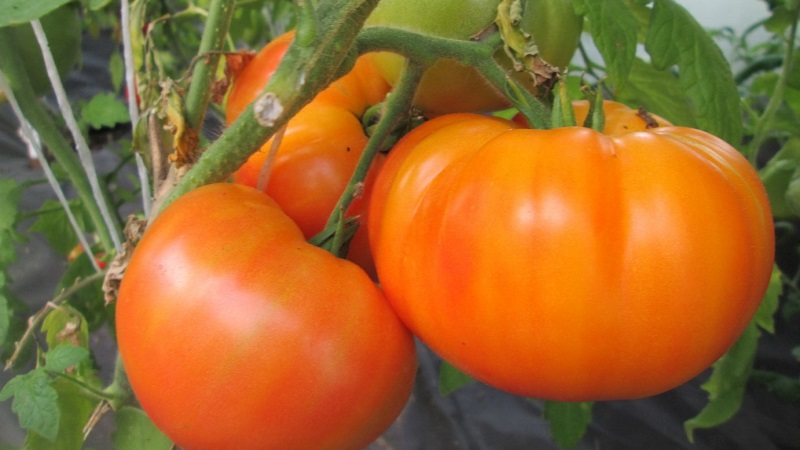
Breeding features
Thanks to domestic breeders, the tomato was bred in 2000.Since the culture was originally created for private gardeners, it is not customary to grow such tomatoes on an industrial scale.
Productivity and fruiting period
In a greenhouse, the crop yields more than in a garden bed without a film cover: up to 6-7 kg of fruits are harvested from one bush per season. 3-4 kg of tomatoes are removed from one plant that grows in the open field. From 1 sq. m vegetable growers receive up to 22 kg of tomatoes.
Full ripening of the Orange variety occurs 3-3.5 months after planting. Tomatoes ripen in stages. Fruiting in the greenhouse begins earlier than in the open field (at the end of July) and continues until mid-October.
For your information. Tomato Orange fresh is unsuitable for long-term storage.
Growing tomatoes
To obtain a high-quality harvest, you should take care of proper soil preparation and the plant itself. Tomato variety Orange is grown both by seedlings and direct sowing in open ground.
On a note. Seed material before sowing must be warmed up at a temperature of 50 ° C and cooled in cold water or soaked in a slightly pink solution of potassium permanganate for 20-30 minutes. This will strengthen the plant's immunity and help to avoid the occurrence of diseases and pests.
Landing
The first days of March are the best time to plant the variety. The drain is placed at the bottom of the container, then covered with a substrate. Organic fertilizers are also added. For the seedlings to sprout faster, the container is placed in a warm place. After 60 days, the bushes are transferred to a permanent place of growth.
If you decide to use the direct planting method (sow tomato seeds directly to the garden), this should be done in early May, in sunny and wind-protected places. With such a planting, you should not count on a quick harvest: the fruits will ripen much longer.
Care
Compliance with the rules of agricultural technology is important for the cultivation of any crop. Knowing some of the nuances will help you achieve high yields without much difficulty.
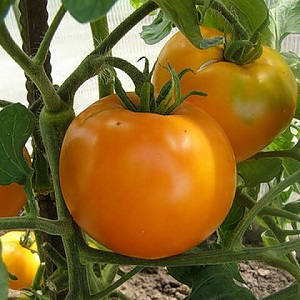 Tomatoes are watered as the soil dries up, but no more than 2-3 times a week. 3-4 liters of water are consumed per bush. Do not forget that the culture is watered exclusively at the root. It is impossible to water under the scorching sun, it is better to choose the morning or evening time for this.
Tomatoes are watered as the soil dries up, but no more than 2-3 times a week. 3-4 liters of water are consumed per bush. Do not forget that the culture is watered exclusively at the root. It is impossible to water under the scorching sun, it is better to choose the morning or evening time for this.
Between water procedures, the soil around the bushes is necessarily loosened, at the same time ridding them of parasitic weeds, which are not as harmless as they seem at first glance. If you do not remove weeds on time, all fertilizing, watering and other measures for caring for tomatoes will be useless. The plant will wither and ache, and the unloved "weeds" will turn green, grow and flourish.
During the growing season, the fruiting crop is fed at least three times. It is better to use organic fertilizers as fertilizers. A week after planting plants in open ground, perform the first top dressing manure at the rate of 1 kg of fertilizer per 1 liter of water. Next time, fertilizing is applied during the flowering period of 2-3 fruit brushes.
Gardeners also recommend using manure, but with the addition of 2-3 g of potassium permanganate and copper sulfate per 10 liters of the mixture. The last time the plants are fertilized during the ripening of the first fruits: manure dissolved in water (1: 1) is also used.
On a note. Tomatoes contain a large amount of nutrients. Regular consumption of tomatoes reduces the risk of depression and cancer. Another big plus of these fruits is that 100 g of a vegetable contains only 22 kcal.
Growing conditions
Tomatoes of the Orange variety need constant pinching. The shoots are pinched as they appear, so that they do not take away the vitality of the plant. Most often, the bush is formed into 1-2 stems. A month before the end of the growing season, the tops of the plant should be pinched and small inflorescences removed.
Diseases and pests
The variety has a strong immunity, but under unfavorable conditions, diseases sometimes affect it.To prevent the risk of morbidity, there are certain preventive measures.
For example, if there is a risk of mosaic infestation, it is better to use seeds from a year ago for planting. And if there is a likelihood of fusarium disease, prevention is carried out in stages, in the first month after disembarkation. For this, "Trichodermin" is used.
The most dangerous disease is the bacterial wilting of the plant. Affected seedlings die within a few days. Harmful microorganisms appear when seeds have not been properly processed before planting. For treatment, the plant must be treated with Fitolavin-300 solution in time. Sick and dead bushes are removed and burned to avoid contamination of neighboring plants.
Breeders claim that Orange is less prone to phytophthorathan other varieties.However, for prevention, it is better to treat bushes with effective means:
- "Barrier";
- "Barrier";
- Fitosporin.
Copper preparations will help protect the culture from fungal diseases.
Orange is a tall variety, which entails certain risks of morbidity. Tomatoes start to rot if they come into contact with the ground. The installation of a trellis system will help to avoid this; it will also be easy to process fruits from small pests on it.
Insects often parasitize the fetus. To avoid this, the bushes are treated with appropriate pesticides, soap solution (100 g of substance per 10 l of water) or garlic infusion in the same proportion (garlic must be suppressed and the mixture allowed to brew for one day).
For your information.Despite the strong immunity of Orange, it is still not worth ignoring preventive measures, because every year viruses mutate, adapting to new blockers and learning to bypass them.
The process of growing tomatoes just described may seem complicated. However, the correct formation of the bush forms a rich tomato ovary. A one and a half meter bush is able to give a bountiful harvest and at the same time save space on the site. Beautiful orange fruits with juicy pulp will decorate the garden and delight with taste. Tomato Orange is a worthy competitor to the traditional red tomato.
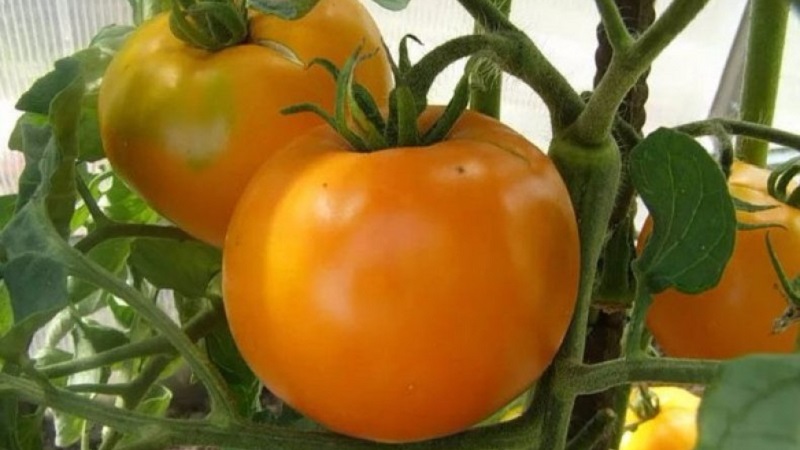
Variety resistance to external factors
Orange fruits are very fond of warmth and react violently to weather changes. In unstable climates, it is recommended to grow the variety in greenhouses, and use the open method only in the southern regions.
Tall tomato bushes do not take the wind very well. They need a garter, or better yet, a safe hiding place.
Reviews of gardeners
Most summer residents have long been familiar with Orange tomatoes and are actively growing them. They emit a unique fruit taste and high yield. Also, the variety makes it possible to use these vegetables for people who are allergic to red tomatoes. Reviews of tomatoes Orange are mostly good.
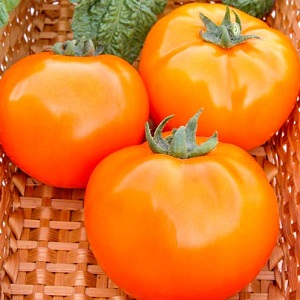 Tatiana, Volgograd: “I have been growing Orange for three years in a row. The description of the variety and the photo on the package with seeds convinced me that this species is worthy of attention. I liked the tomatoes for their unsurpassed taste. Before that, I really liked the Pink Giant, but after preparing the salad with Orange tomatoes, my whole family stopped recognizing other tomatoes. The grandchildren are asking them to prepare "red-haired" juice, they really liked it. I grow a lot of tomatoes: enough for food, and for sale, and for conservation. I recommend this variety to everyone. "
Tatiana, Volgograd: “I have been growing Orange for three years in a row. The description of the variety and the photo on the package with seeds convinced me that this species is worthy of attention. I liked the tomatoes for their unsurpassed taste. Before that, I really liked the Pink Giant, but after preparing the salad with Orange tomatoes, my whole family stopped recognizing other tomatoes. The grandchildren are asking them to prepare "red-haired" juice, they really liked it. I grow a lot of tomatoes: enough for food, and for sale, and for conservation. I recommend this variety to everyone. "
Evgeniy, Tula: “I learned about Orange from my neighbor in the country. Once he treated me to a get-together, after which I immediately asked him for seeds. I don't let anyone near the tomatoes, I grow them myself. When my wife saw yellow tomatoes in the garden, she laughed that I grow oranges. The fruits were liked for their taste, aroma, structure and large size. He could not pull his wife by the ears. I would not say that the harvest is greater than that of other varieties, but not less. I am satisfied, I will continue to grow ”.
Svetlana, Ivanovo: “We have always grown tomatoes in the country.With the advent of the granddaughter, they began to plant yellow varieties, since she has diathesis and an allergy to everything red, and the child loves tomatoes and picks them right from the garden - you can't keep track of them. The whole family really liked the Orange variety. These tomatoes do not cause any reaction in the granddaughter, except for a positive one, even if she drinks the juice. In general, I can say that the variety is very good. This is a worthy replacement for red tomatoes. They don't need special care. "
Conclusion
Orange (tomat Orange) is a healthy and beautiful tomato with a bright taste and aroma. It is grown by both novice summer residents and experienced gardeners. Tall bushes give a bountiful harvest of large fruits, albeit not too early.
Strong immunity and timely prevention will help you forget about problems with diseases and pests. An important benefit of Orange is that it is non-hybrid so you don't have to buy seeds every year to grow it.